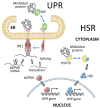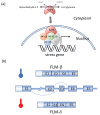Heat Stress Responses and Thermotolerance in Maize
- PMID: 33477941
- PMCID: PMC7833377
- DOI: 10.3390/ijms22020948
Heat Stress Responses and Thermotolerance in Maize
Abstract
High temperatures causing heat stress disturb cellular homeostasis and impede growth and development in plants. Extensive agricultural losses are attributed to heat stress, often in combination with other stresses. Plants have evolved a variety of responses to heat stress to minimize damage and to protect themselves from further stress. A narrow temperature window separates growth from heat stress, and the range of temperatures conferring optimal growth often overlap with those producing heat stress. Heat stress induces a cytoplasmic heat stress response (HSR) in which heat shock transcription factors (HSFs) activate a constellation of genes encoding heat shock proteins (HSPs). Heat stress also induces the endoplasmic reticulum (ER)-localized unfolded protein response (UPR), which activates transcription factors that upregulate a different family of stress response genes. Heat stress also activates hormone responses and alternative RNA splicing, all of which may contribute to thermotolerance. Heat stress is often studied by subjecting plants to step increases in temperatures; however, more recent studies have demonstrated that heat shock responses occur under simulated field conditions in which temperatures are slowly ramped up to more moderate temperatures. Heat stress responses, assessed at a molecular level, could be used as traits for plant breeders to select for thermotolerance.
Keywords: heat stress; maize; post-transcriptional regulation; transcriptional regulation.
Conflict of interest statement
The authors declare no conflict of interest.
Figures





Similar articles
-
The Transcription Factor bZIP60 Links the Unfolded Protein Response to the Heat Stress Response in Maize.Plant Cell. 2020 Nov;32(11):3559-3575. doi: 10.1105/tpc.20.00260. Epub 2020 Aug 25. Plant Cell. 2020. PMID: 32843434 Free PMC article.
-
ZmHsf05, a new heat shock transcription factor from Zea mays L. improves thermotolerance in Arabidopsis thaliana and rescues thermotolerance defects of the athsfa2 mutant.Plant Sci. 2019 Jun;283:375-384. doi: 10.1016/j.plantsci.2019.03.002. Epub 2019 Mar 18. Plant Sci. 2019. PMID: 31128708
-
CaHsfA1d Improves Plant Thermotolerance via Regulating the Expression of Stress- and Antioxidant-Related Genes.Int J Mol Sci. 2020 Nov 8;21(21):8374. doi: 10.3390/ijms21218374. Int J Mol Sci. 2020. PMID: 33171626 Free PMC article.
-
Prospects of engineering thermotolerance in crops through modulation of heat stress transcription factor and heat shock protein networks.Plant Cell Environ. 2015 Sep;38(9):1881-95. doi: 10.1111/pce.12396. Epub 2014 Aug 6. Plant Cell Environ. 2015. PMID: 24995670 Review.
-
[Regulation of heat shock gene expression in response to stress].Mol Biol (Mosk). 2017 May-Jun;51(3):400-417. doi: 10.7868/S0026898417020100. Mol Biol (Mosk). 2017. PMID: 28707656 Review. Russian.
Cited by
-
Biochar Implications Under Limited Irrigation for Sweet Corn Production in a Semi-Arid Environment.Front Plant Sci. 2022 Apr 22;13:853746. doi: 10.3389/fpls.2022.853746. eCollection 2022. Front Plant Sci. 2022. PMID: 35528935 Free PMC article.
-
Reactive Oxygen Species: A Crosslink between Plant and Human Eukaryotic Cell Systems.Int J Mol Sci. 2023 Aug 22;24(17):13052. doi: 10.3390/ijms241713052. Int J Mol Sci. 2023. PMID: 37685857 Free PMC article. Review.
-
ZmNF-YA1 Contributes to Maize Thermotolerance by Regulating Heat Shock Response.Int J Mol Sci. 2024 Jun 6;25(11):6275. doi: 10.3390/ijms25116275. Int J Mol Sci. 2024. PMID: 38892463 Free PMC article.
-
Analysis of the Mechanisms Underlying the Specificity of the Variation Potential Induced by Different Stimuli.Plants (Basel). 2024 Oct 16;13(20):2896. doi: 10.3390/plants13202896. Plants (Basel). 2024. PMID: 39458843 Free PMC article.
-
Identification of key genes and molecular pathways regulating heat stress tolerance in pearl millet to sustain productivity in challenging ecologies.Front Plant Sci. 2024 Aug 22;15:1443681. doi: 10.3389/fpls.2024.1443681. eCollection 2024. Front Plant Sci. 2024. PMID: 39239194 Free PMC article.
References
-
- Prasad P., Bheemanahalli R., Jagadish S.V.K. Field crops and the fear of heat stress—Opportunities, challenges and future directions. Field Crop. Res. 2017;200:114–121. doi: 10.1016/j.fcr.2016.09.024. - DOI
-
- Hoegh-Guldberg O., Jacob D., Taylor M., Bindi M., Brown S., Camilloni I., Diedhiou A., Djalante R., Ebi K., Engelbrecht F., et al. Global Warming of 1.5 °C. An IPCC Special Report on the Impacts of Global Warming of 1.5 °C above Preindustrial Levels and Related Global Greenhouse Gas Emission Pathways, in the Context of Strengthening the Global Response to the Threat of Climate Change. Intergovernmental Panel on Climate Change; Geneva, Switzerland: 2018. Chapter 3: Impacts of 1.5 °C global warming on natural and human systems; pp. 175–311. Specical Report.
-
- Obata T., Witt S., Lisec J., Palacios-Rojas N., Florez-Sarasa I., Yousfi S., Araus J.L., Cairns J.E., Fernie A.R. Metabolite profiles of maize leaves in drought, heat and combined stress field trials reveal the relationship between metabolism and grain yield. Plant Physiol. 2015;169:2665–2683. doi: 10.1104/pp.15.01164. - DOI - PMC - PubMed
Publication types
MeSH terms
Substances
Grants and funding
LinkOut - more resources
Full Text Sources
Other Literature Sources

